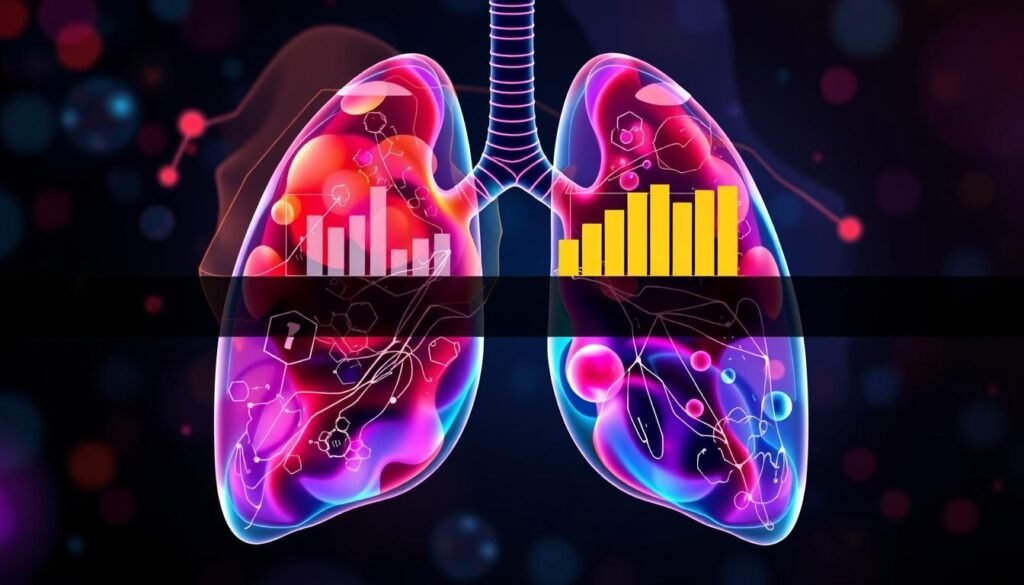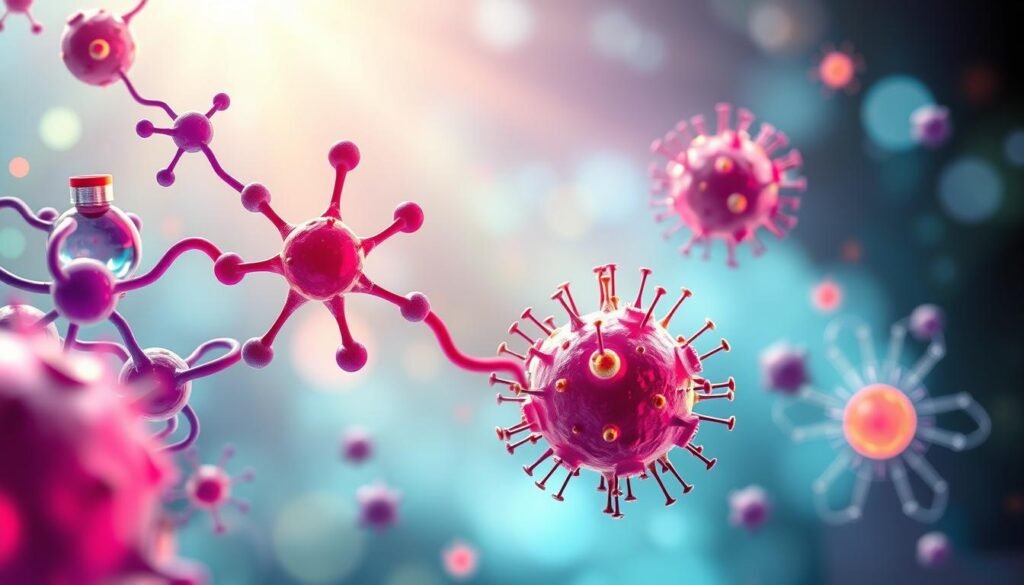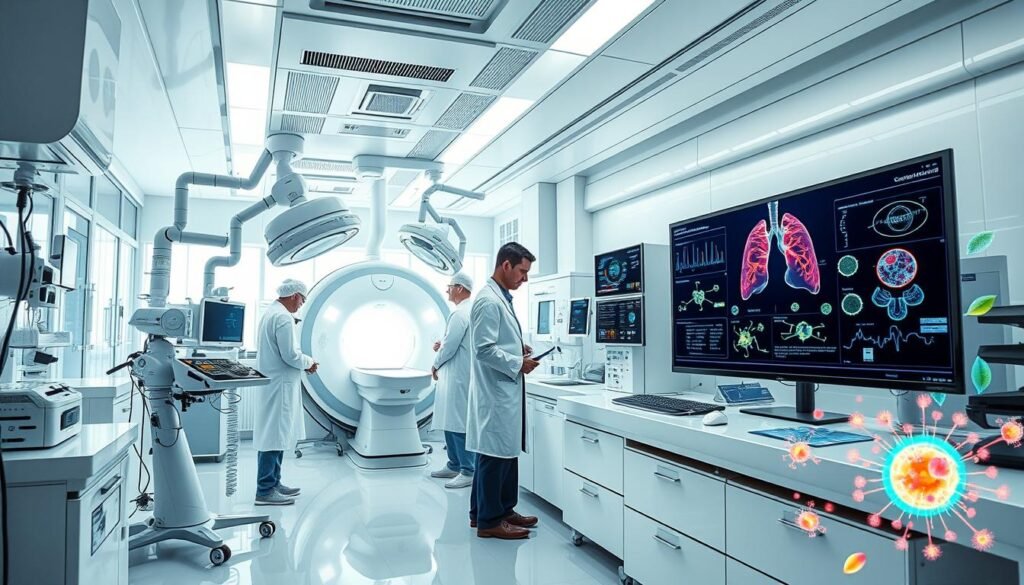Did you know almost 70% of lung cancer patients have non-small cell lung cancer (NSCLC)? This fact greatly impacts how effective chemotherapy can be. It’s vital to know what influences chemo’s success in treating lung cancer. These factors help decide treatment options, better outcomes, and enable doctors to make wise choices.
Exploring the biological and clinical aspects important to chemotherapy and lung cancer helps. By understanding these, we can see how they affect treatment results. This leads to better patient care and higher success in fighting lung cancer.
Key Takeaways
- Understanding lung cancer type is critical for effective chemotherapy decisions.
- Patient health and performance status significantly influence treatment outcomes.
- The presence of comorbidities can complicate treatment plans.
- Chemotherapy regimens vary based on specific lung cancer characteristics.
- Regular monitoring is essential to assess the chemotherapy response.
Introduction to Lung Cancer and Chemotherapy
Lung cancer is the top cause of cancer deaths around the world. Many patients find out they have it at a late stage. This can limit their treatment options. Lung cancer introduction shows the hurdles this illness brings. Lung cancer has two main kinds: non-small cell lung cancer (NSCLC) and small cell lung cancer (SCLC). Both types need different plans for treatment, depending on how they grow and spread.
Chemotherapy plays a key role in treating lung cancer. Chemotherapy basics explain how drugs are used to halt cancer cell growth. SCLC often gets treated with chemotherapy because it responds well to it. On the other hand, NSCLC might need chemotherapy after surgery or if surgery isn’t an option. This shows the variety of lung cancer treatment options available, aiming to give every patient the best care.
Knowing about lung cancer and chemotherapy’s importance helps patients and their caregivers make wise choices about treatment.
| Treatment Type | SCLC | NSCLC |
|---|---|---|
| Primary Treatment | Chemotherapy | Surgery followed by chemotherapy if localized |
| Alternate Options | Chemotherapy combined with radiotherapy/immunotherapy | Chemotherapy if surgery is not possible |
| Medical Approach | Often responds well to drugs | Treatment based on stage and patient health |
Understanding Lung Cancer Staging
Lung cancer staging is key in diagnosing and planning treatment. It helps doctors make the best choices for patient care. By looking at the cancer’s spread, doctors can pick the right treatments and predict outcomes. The process of finding the stage involves several factors, like the disease’s extent and the best treatment path.
Importance of Accurate Staging
Getting the lung cancer stage right is vital for treatment and results. Knowing about non-small cell lung cancer (NSCLC) stages guides personalized treatment. This can depend on the tumor’s features, and the patient’s health. The staging starts with exams like imaging and biopsies, with more tests if needed. Knowing the stage is crucial for planning treatment and figuring out the prognosis. Early stages often mean a better chance, while advanced stages pose more challenges.
Stages of Non-Small Cell Lung Cancer
Non-small cell lung cancer comes in four stages:
| Stage | Description |
|---|---|
| Stage 0 | Carcinoma in situ; cancer is limited to the top layer of airways. |
| Stage I | A localized tumor with little spread; surgery is usually the treatment. |
| Stage II | Tumor has spread to nearby lymph nodes; treatment might involve chemotherapy and surgery. |
| Stage III | There’s a lot of local and regional spread; treatment can include chemotherapy, radiation, and surgery. |
| Stage IV | This advanced stage means cancer has spread far; treatment varies, often involving several methods. |
The TNM system is used to figure out lung cancer’s exact stage. It looks at tumor size and location (T), lymph nodes (N), and if it has spread (M). The more advanced the stage, the more likely it is that systemic therapies, like chemotherapy, will be used. Accurate staging is key for planning treatment and understanding the prognosis, offering essential info on how the disease might progress.
Factors Affecting the Success of Chemotherapy for Lung Cancer
The success of chemotherapy for treating lung cancer hinges on several vital factors. A patient’s general health and how active they are, are key. It’s crucial to closely evaluate these areas before starting treatment. How these aspects interact with other health issues can greatly impact chemo choices.
Patient’s Overall Health and Performance Status
A patient’s health greatly affects how well chemotherapy works. Research showed that 94 patients had moderate to poor activity levels. This was in stark contrast to 365 individuals with little to no activity problems. Such significant differences underline that poor health can limit treatment options. Those with low health scores may not be fit for strong treatments.
Impact of Comorbidities on Treatment Decisions
Having other illnesses makes lung cancer treatment more complicated. Factors like gender, emotional well-being, and overall quality of life are important. Physical ability, protein, and blood levels also play a role in deciding if chemo is suitable. These illnesses can make choosing the right treatment path harder. They affect how practical chemotherapy options are.
Cancer Genetic Mutations and Their Role
Learning about cancer genetic mutations is key in treating lung cancer. These mutations shape how patients respond to treatments. By identifying these changes, doctors can offer more personalized care. This leads to better outcomes for patients.
Common Genetic Mutations in Lung Cancer
Several important genetic mutations are known to impact lung cancer treatment. The most common ones include:
- TP53: Found in about 65% of lung cancer cases, it affects how well treatments work.
- EGFR: Mutations such as EGFR-L858R and EGFR-T790M are targeted by special drugs, like tyrosine kinase inhibitors.
- KRAS: Another frequent mutation that impacts treatment results.
- ALK: Fusions which are sensitive to certain targeted treatments.
Genetic tests can detect these mutations, helping doctors choose the best treatment. Options include targeted therapies or immunotherapy. These advanced treatments can be more effective for specific genetic changes.
How Genetic Changes Affect Treatment Choices
Genetic testing in lung cancer is crucial. For folks with certain mutations like EGFR, standard chemotherapy might not work well. Instead, drugs like erlotinib and gefitinib, which target EGFR mutations, could be better options.
Without these mutations, patients might need standard chemotherapy. Knowing if a mutation is present can change the treatment plan, improving outcomes. This tailored approach marks a big step forward in lung cancer treatment.
For more details on how cancer genetic mutations impact treatment, check out this resource.
Choosing the Right Chemotherapy Regimen
Choosing the correct chemotherapy treatment is crucial for lung cancer patients. This choice helps achieve the best results. The selection process looks at the lung cancer type, patient health, and treatment goals.
In non-small cell lung cancer (NSCLC), chemotherapy helps at different times. It may be used before or after surgery to tackle cancer that has spread. Doctors usually recommend two drugs together, like cisplatin or carboplatin and another drug. In tougher cases, they might use just one drug, based on the patient’s health.
Early-stage lung cancer treatment often lasts three to four months. For advanced cancer, treatment length depends on how the patient reacts and the treatment’s success. The first treatments for advanced cancer generally take four to six cycles. Then, doctors may suggest ongoing therapy to keep the cancer at bay.
It’s important to know about side effects, like hair loss, feeling sick, throwing up, and getting infections easily. Knowing about lung cancer chemotherapy and its side effects helps patients and doctors decide together.
Here’s a table showing common lung cancer chemotherapy treatments and how they’re used:
| Cancer Type | Common Regimens | Typical Treatment Duration |
|---|---|---|
| Non-Small Cell Lung Cancer (NSCLC) | Cisplatin + Docetaxel, Carboplatin + Paclitaxel | 3-4 months for early stage, 4-6 cycles for advanced |
| Small Cell Lung Cancer (SCLC) | Cisplatin + Etoposide, Carboplatin + Etoposide | 4-6 cycles, may extend with single-agent therapy |
Monitoring Treatment Response
Checking how well treatment works is key in lung cancer care. Doctors look closely at how patients react to chemotherapy. This helps them change treatment if needed. It helps track the disease and improve chances of success.
Importance of Regular Evaluations
It’s important to keep checking if chemotherapy is working. This includes many ways to see how patients are doing. These checks make sure the treatment is still right. Without them, treatment that doesn’t work could go on too long. This could harm survival chances and life quality.
Methods of Response Assessment
There are many ways to check how lung cancer treatments are working. One key method is RECIST. It looks at tumor size and other signs. There are other ways too:
- Imaging studies (CT scans, MRIs): These show if tumors are getting smaller.
- Biomarker analysis: This finds genetic changes that show how treatment is working.
- Symptom assessment: Patients share how they feel during treatment.
Mixing these methods gives a full picture of treatment success. Looking at gene changes in certain tests can be very telling. Studies show many lung cancer patients have the same mutations seen in their main tumors. This info helps tailor treatment better.
| Assessment Method | Purpose |
|---|---|
| Imaging Studies | To see changes in tumor size and check for growth. |
| Biomarker Analysis | To find genetic changes and guess how well treatment will work. |
| Symptom Assessment | To understand how patients feel and the side effects of treatment. |

Side Effect Management and Patient Care
Chemotherapy is a key treatment for lung cancer. However, it comes with significant chemotherapy side effects. These can lower a patient’s quality of life. To improve this, patient care strategies are necessary. They focus on managing symptoms like fatigue, nausea, and infection risks.
The way people respond to chemotherapy varies a lot. So, handling side effects must be personalized. Health experts need to know each patient’s unique side effects. These can be:
- Fatigue and weakness
- Nausea and vomiting
- Anemia leading to breathlessness
- Increased susceptibility to infections
- Changes in taste and smell
Key to comfort is the right medicines, like those for nausea. Blood transfusions might be needed for severe anemia or low platelets. This shows why ongoing evaluations and blood tests are critical during treatment.
After therapy ends, side effects can last for a while, making recovery hard. Staying hydrated helps protect the kidneys. A fiber-rich diet can help avoid constipation and nausea. Custom care plans help patients deal with chemotherapy. They can then focus on feeling better overall. For extra information, one should look into new therapy developments. These could also help improve patient recovery.
Combination Therapies for Enhanced Efficacy
Combining treatments for lung cancer has significantly changed how it’s fought. Doctors use immunotherapy and chemotherapy together. This improves how effective treatments are and helps patients more.
By using different drugs and treatments, doctors can attack more cancer cells. This increases the chances of beating the cancer.
Benefits of Combining Chemotherapy with Immunotherapy
Adding immunotherapy to chemotherapy has big benefits for lung cancer treatment. Studies show that this mix can make patients live longer and respond better to treatment. It fights cancer by boosting the immune system and shrinking tumors.
Chemotherapy helps immunotherapy work even better against cancer. New drugs like Pembrolizumab and Nivolumab are now approved. They open new doors for doctors and patients.
Use of Targeted Therapy in Treatment Plans
Targeted therapy is very important for treating lung cancer, especially with other therapies. It focuses on the cancer’s specific genes and how it grows. This makes the overall treatment more thorough.
Atezolizumab and Encorafenib are two drugs used in these combinations. They help doctors plan treatments that work better. Using different therapies together fights drug resistance and has fewer side effects. This means treatment is safer and more successful.
Age and its Impact on Treatment Outcomes
The age impact chemotherapy lung cancer greatly affects how patients are treated and their results. About 60% of cancer cases and 70% of cancer deaths occur in those over 65. This group faces more health issues and disabilities, impacting their treatment choices. Now, around 6 million cancer survivors 65 and older have received different treatments.
Older people were often left out of past research. This led to less information on how effective chemotherapy is for them. Up to 60% of those 65-74 and over 76% of those 80+ have disabling conditions. Thus, treating older adults means thinking about their whole health, not just fighting cancer.
Older patients often get lower doses of chemotherapy due to worries about harmful effects. The comprehensive geriatric assessment (CGA) helps figure out who might handle aggressive treatment well. It also shows who might be better off with care focused on comfort. Knowing about a person’s mental health and support network is also vital for better care.
| Age Group | Cancer Incidence (%) | Cancer Mortality (%) | Percentage Receiving Chemotherapy |
|---|---|---|---|
| 65 and Older | 60% | 70% | Approx. 43% (Age >80) |
| Under 65 | 40% | 30% | Approx. 73% (Age ≤80) |
We need more research on how older adults handle treatment, especially those who are very weak. Social support is crucial for sticking with treatment and achieving good outcomes. Detailed studies on this can help us find better ways to treat older lung cancer patients. A look at past studies confirms this need.
Recent Advances in Lung Cancer Treatment
The world of lung cancer treatment is changing fast with big steps forward. Now, there are new therapies for lung cancer. These include advanced immunotherapies and treatments designed for the tumor’s genetic type.
Innovative Therapies on the Horizon
Our knowledge of lung cancer is growing. Because of this, we’re finding new ways to treat it. The use of immunotherapies, like PD-1 and PD-L1 inhibitors, is a big change in treating non-small cell lung cancer (NSCLC).
These new treatments can be used on their own or with traditional chemotherapy. This gives patients more choices.
Targeted therapies are now key in treating lung cancer. There are FDA-approved treatments that target specific genetic changes. They work well for late-stage lung cancer and have fewer side effects than old-school chemo. This is great news for people with advanced NSCLC.
Clinical trials are exploring even more treatment options. These trials offer new therapies and help researchers learn more. The goal is to find better ways to treat lung cancer. With these advances, patients could see better survival rates and quality of life. Check out more on advances in lung cancer treatment.

| Therapy Type | Description | Examples |
|---|---|---|
| Immunotherapy | Utilizes the body’s immune system to fight cancer cells. | PD-1 inhibitors, CTLA-4 inhibitors |
| Targeted Therapy | Aims at specific genetic mutations in cancer cells. | EGFR inhibitors, ALK inhibitors |
| Combination Therapy | Combines different treatment modalities for enhanced efficacy. | Bevacizumab with chemotherapy |
Patient Education and Awareness
Effective lung cancer patient education is key to better care during chemotherapy. It helps patients understand their diagnosis and treatment choices. Learning about chemotherapy options makes the process clearer. It helps patients work together with their doctors.
Many patients don’t fully get what chemotherapy does. For example, 69% of lung cancer patients didn’t know it often doesn’t cure cancer. This shows we need to teach more. Groups like nonwhite and Hispanic patients often believe wrong info about chemotherapy. This means we need to teach differently to different groups.
We should teach about several topics, including:
- Understanding treatment options available for lung cancer
- Managing side effects associated with chemotherapy
- Recognizing the importance of mental health support during treatment
Creating programs on these topics can make a big difference. For instance, people in education programs often feel less depressed. Talking well with your doctor helps too. By improving lung cancer patient education, patients can make better health choices.
| Key Aspects | Impact on Patients |
|---|---|
| Patient Understanding | Improves treatment compliance |
| Management of Side Effects | Enhances quality of life |
| Mental Health Support | Reduces anxiety and depression rates |
| Informed Decision-Making | Increases patient empowerment |
A good education plan greatly helps lung cancer patients with chemotherapy. It leads to better results and more satisfaction with treatment.
Conclusion
The success of lung cancer chemotherapy depends on many things. This includes genetic makeup, health status, and other health issues a patient might have. For example, someone with stage IV lung cancer has about a 10% chance of surviving 5 years. This is much lower than the 68% chance for those at stage IB. It shows why doctors must look closely at each patient’s unique case.
Several factors impact how well chemotherapy works. Age, income, and education level are a few of these. Older people might say no to chemotherapy more often. But, those with more education are likely to accept it. These facts help us understand why treatment works for some and not for others.
New treatments for lung cancer are always being developed. As we learn more, doctors can get better at using chemotherapy. They aim to lift survival rates and make life better for those with lung cancer. Keeping track of all that influences treatment success helps in this mission.